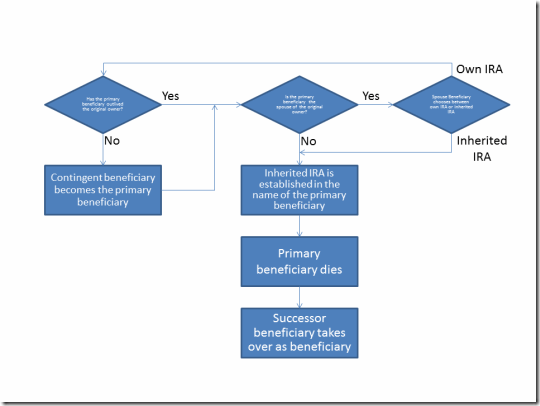 |
When an IRA owner dies while the IRA still has funds in it, the primary beneficiary(ies) have the opportunity to transfer the account to an inherited IRA and begin taking the Required Minimum Distributions (RMDs) over his or her lifetime. When this primary beneficiary dies, it can be difficult to figure out who the money goes to. This is known as the successor beneficiary.
It’s important to know the difference between a successor beneficiary and a contingent beneficiary. A contingent beneficiary takes the place of the primary beneficiary in the event that the primary beneficiary dies before the original owner does. A successor, on the other hand, takes the place of the primary beneficiary when the primary beneficiary outlives the original owner. So it’s a matter of timing. What we’re interested in is the successor beneficiary.
There are four main ways that a successor beneficiary is determined:
- Successor is named by the primary beneficiary. When the inherited IRA is established, the primary beneficiary has the opportunity to name one or more beneficiaries of the inherited IRA, along with contingent beneficiaries if desired.
- Successor is the primary beneficiary’s estate. If the primary beneficiary hasn’t designated a beneficiary of the inherited IRA, the primary beneficiary’s estate becomes the successor beneficiary of the IRA.
- Custodial documents name a successor beneficiary. Some IRA custodians provide for the designation of a successor beneficiary in the original plan documents. This is relatively rare, and even more rare that a successor is actually named.
- Original owner names a successor beneficiary. Sometimes the original owner has had the foresight to utilize a trust document of some variety to control succession among beneficiaries. In a case like this, the trust is the primary beneficiary, and the trust has a primary beneficiary and successor beneficiary(ies).
Below is a flowchart which describes how the ownership of an IRA flows to different beneficiaries. (click on the chart to see a larger view)
Distribution for the Successor Beneficiary
So, having sorted out that we are working with the appropriate successor beneficiary, we need to determine what is the proper distribution period for the successor beneficiary. As we know, if the IRA is an inherited IRA, it is subject to Required Minimum Distributions, over a period determined by the beneficiary’s age at the time of the death of the original owner. This figure is determined from Table I in the first year of distribution (the year after the death of the original owner), and is a set period of time. The factor from Table I is used in the first year, and each subsequent year one is subtracted from the first factor and the IRA is distributed based on that amount.
So, for example, if the beneficiary is 71 years of age in the first year of distribution, according to Table I the factor is 16.3. The IRA value is divided by 16.3 to come up with the RMD for the first year. Each subsequent year 1 is subtracted from the Table I factor, so that the IRA is distributed over 16.3 years. This is known as the Applicable Distribution Period, or ADP.
When a successor beneficiary takes over to receive distributions from the inherited IRA, the original ADP is still in effect, and the IRA must be distributed over that remaining period to the successor beneficiary(ies).
Complications
Several factors can add a considerable degree of complication to the process – such as if there are multiple primary beneficiaries and/or multiple successor beneficiaries.
Each primary beneficiary is treated separately, and the successors for each (unless determined by the original plan as mentioned above) are determined by the individual beneficiary. When there are multiple successors, each one is treated separately and the original ADP for the applicable primary beneficiary applies to all successors pro rata for the successor’s share.
Another complication is when one or more beneficiaries disclaims the inheritance. In a case like that, first it is determined whether the original beneficiary designation had pre-determined the successor for each primary beneficiary (such as “per stirpes”, meaning that the heirs of the original beneficiary are bequeathed the disclaimed share). In the absence of this sort of designation, the other beneficiaries in the primary class take over the disclaimed share.
Of course in the real world there are many, many more complications, but this should give you a place to start. Use the comments section below to bring in your more complex situations and we’ll work them out.




 Sterling Raskie, MSFS, CFP®, ChFC®
Sterling Raskie, MSFS, CFP®, ChFC® The latest in our Owner’s Manual series, A 401(k) Owner’s Manual, was published in January 2020 and is available on
The latest in our Owner’s Manual series, A 401(k) Owner’s Manual, was published in January 2020 and is available on  A Medicare Owner’s Manual, is updated with 2020 facts and figures. This manual is available on
A Medicare Owner’s Manual, is updated with 2020 facts and figures. This manual is available on  Social Security for the Suddenly Single can be found on Amazon at
Social Security for the Suddenly Single can be found on Amazon at  Sterling’s first book, Lose Weight Save Money, can be
Sterling’s first book, Lose Weight Save Money, can be  An IRA Owner’s Manual, 2nd Edition is available for purchase on Amazon. Click the link to choose the
An IRA Owner’s Manual, 2nd Edition is available for purchase on Amazon. Click the link to choose the  Jim’s book – A Social Security Owner’s Manual, is now available on Amazon. Click this link for the
Jim’s book – A Social Security Owner’s Manual, is now available on Amazon. Click this link for the  And if you’ve come here to learn about queuing waterfowl, I apologize for the confusion. You may want to discuss your question with Lester, my loyal watchduck and self-proclaimed “advisor’s advisor”.
And if you’ve come here to learn about queuing waterfowl, I apologize for the confusion. You may want to discuss your question with Lester, my loyal watchduck and self-proclaimed “advisor’s advisor”.
I have a question for you. Here is the situation. Our mother died in July 2017 in Arizona. She left her ira to her 4 children(each 25%), no spouse involved. The spouse is still alive. Three of us claimed our inheritance and opened up inherited ira accounts. The fourth child has not claimed his inheritance nor did he disclaim it. He basically has nothing at all to do with the family and does not communicate with us. The money ($30,000) now sits in her original ira account. I have been told the money eventually goes to the state of Arizona and oppositely have also been told the money eventually gets distributed to the other 3 children. This coming from 2 different people at the same brokerage.
What happens to the money? If the money gets distributed to the other 3 children when would this happen?
I believe this is a question of state handling of estates. An estate attorney would be your best bet to help you figure out how this will be handled.
Your final statement: “In the absence of this sort of designation, the other beneficiaries in the primary class take over the disclaimed share” raises some questions.
If there are no other primary beneficiaries, I assume the contingent beneficiaries would inherit the disclaimed share, correct? If so, is it possible for the primary beneficiary to change the contingent beneficiaries (and/or their percentages of the disclaimed amount)? For example, say the spouse is the primary beneficiary and three children are equal contingent beneficiaries of the original IRA. The spouse decides to disclaim the entire IRA, but determines that one of the children does not need the money. Upon disclaiming the IRA, can the spouse specify that only the two needy children will inherit and not the other child?
Typically the designations made by the original owner cannot be changed, other than by disclaimer. So in the situation you described, the spouse beneficiary could disclaim, but the contingent bene’s would remain as they were designated by the original owner. That doesn’t mean that the third contingent bene couldn’t be cajoled into also disclaiming his or her portion, allowing the other two to split the inheritance evenly.
Generally the designations of beneficiaries on an IRA can’t be changed after the death of the original owner.
Another way this situation could be handled would be for the spouse beneficiary to take ownership of the IRA, which would allow him or her to make whatever beneficiary designations he or she wishes. The downside to this is that the spouse beneficiary has to continue with ownership (including taking distributions when required) for the rest of his or her life, before passing the IRA along to the desired heirs.
Hope this helps –
jb